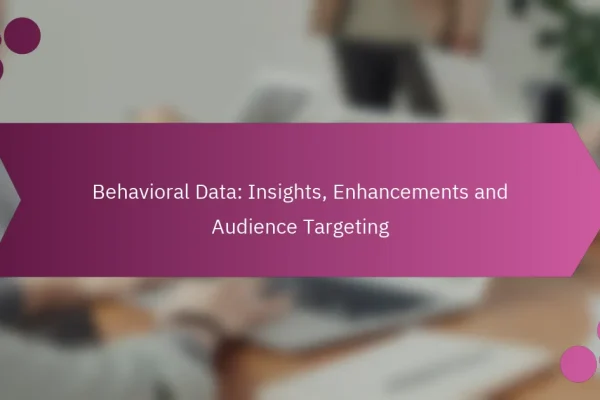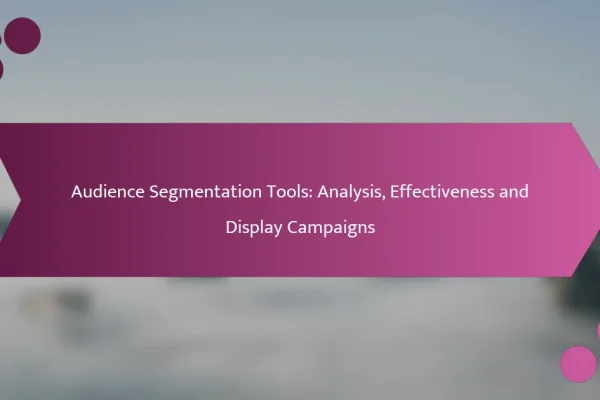How to effectively segment target audiences for display advertising?
Effectively segmenting target audiences for display advertising involves dividing potential customers into distinct groups based on shared characteristics. This approach allows advertisers to tailor their messages and optimize their campaigns for better engagement and conversion rates.
Demographic segmentation
Demographic segmentation focuses on characteristics such as age, gender, income, education, and family size. By understanding these factors, advertisers can create targeted messages that resonate with specific groups. For instance, a luxury brand may target high-income individuals aged 30-50, while a children’s toy company might focus on parents with young children.
When implementing demographic segmentation, consider using surveys or customer data analytics to gather relevant information. This data can help refine your audience and improve ad relevance.
Behavioral segmentation
Behavioral segmentation categorizes audiences based on their interactions with a brand, including purchasing behavior, product usage, and brand loyalty. This method allows advertisers to tailor their strategies based on how customers engage with their products. For example, frequent buyers may receive loyalty discounts, while first-time visitors might see introductory offers.
To effectively use behavioral segmentation, track user actions through analytics tools and adjust campaigns based on observed behaviors. This approach can significantly enhance the effectiveness of display ads.
Geographic segmentation
Geographic segmentation divides audiences based on their location, such as country, region, city, or even climate. This is particularly useful for businesses with location-specific products or services. For instance, a winter clothing retailer may focus its advertising efforts in colder regions during the winter months.
When using geographic segmentation, consider local customs, languages, and economic conditions. Tailoring your ads to reflect local culture can improve engagement and conversion rates.
Psychographic segmentation
Psychographic segmentation categorizes audiences based on their lifestyles, values, interests, and personalities. This approach goes beyond demographics to understand what motivates consumers. For example, eco-conscious consumers may respond well to brands that emphasize sustainability in their advertising.
To implement psychographic segmentation, conduct market research to gather insights into your audience’s preferences and values. This information can help craft compelling messages that resonate on a deeper level.
Technographic segmentation
Technographic segmentation focuses on the technology usage and preferences of consumers, including devices, software, and online behavior. Understanding the tech landscape can help advertisers tailor their campaigns to fit the platforms their audience uses most. For example, a mobile app might target users who primarily access content through smartphones.
Utilize analytics tools to assess the technology habits of your audience. This data can inform decisions about ad formats and channels, ensuring your campaigns reach the right users effectively.
What tools can enhance audience segmentation in display advertising?
Several tools can significantly improve audience segmentation in display advertising by providing insights into user behavior, demographics, and interests. Utilizing these tools allows marketers to create more targeted campaigns, ultimately increasing engagement and conversion rates.
Google Ads Audience Insights
Google Ads Audience Insights offers valuable data about potential customers based on their search behavior and interactions with ads. This tool allows advertisers to segment audiences by demographics, interests, and online behavior, enabling tailored ad experiences.
To effectively use Google Ads Audience Insights, start by analyzing existing audience data to identify trends. Create segments based on user characteristics such as age, gender, and interests, and adjust your campaigns accordingly to maximize relevance and impact.
Facebook Audience Insights
Facebook Audience Insights provides detailed demographic and psychographic information about users on the platform. This tool helps advertisers understand their audience’s preferences and behaviors, allowing for more precise targeting in display ads.
Utilize Facebook Audience Insights by exploring audience segments based on location, interests, and behaviors. Regularly update your audience profiles to reflect changes in user behavior and preferences, ensuring your campaigns remain effective and relevant.
Segment.io
Segment.io is a customer data platform that centralizes user data from various sources, enabling better audience segmentation. By integrating data from different channels, marketers can create a comprehensive view of their audience, enhancing targeting capabilities in display advertising.
To leverage Segment.io effectively, ensure that all data sources are connected and that data is clean and organized. Use the insights gained to create detailed audience profiles and tailor your advertising strategies to meet specific user needs.
HubSpot Marketing Hub
HubSpot Marketing Hub offers tools for audience segmentation through its CRM and marketing automation features. This platform allows marketers to segment audiences based on behavior, engagement, and demographic data, facilitating personalized marketing efforts.
To make the most of HubSpot Marketing Hub, regularly analyze user interactions and engagement metrics. Create targeted campaigns based on these insights, and continuously refine your audience segments to improve campaign performance and ROI.
What are the best practices for audience targeting in display advertising?
Effective audience targeting in display advertising involves understanding your audience’s preferences and behaviors to deliver relevant ads. Best practices include utilizing data analytics, segmenting your audience, and continuously optimizing your strategies.
Utilizing A/B testing
A/B testing is a method where two versions of an ad are shown to different audience segments to determine which performs better. This practice helps identify the most effective messaging, visuals, and calls to action. Aim to test one variable at a time for clearer insights.
For instance, you might test two different headlines or images to see which garners more clicks. Regularly conducting A/B tests can significantly enhance your ad performance over time.
Implementing retargeting strategies
Retargeting involves showing ads to users who have previously interacted with your website or content. This strategy keeps your brand in front of potential customers who have already expressed interest, increasing the likelihood of conversion. Consider segmenting your retargeting audience based on their actions, such as page visits or cart abandonment.
For example, you can create specific ads for users who viewed a product but did not purchase it. This tailored approach often leads to higher engagement rates and improved return on ad spend.
Leveraging lookalike audiences
Lookalike audiences are a powerful targeting tool that allows you to reach new users similar to your existing customers. By analyzing the characteristics of your current audience, you can create profiles that help identify potential customers with similar interests and behaviors. This method can expand your reach effectively.
To implement this, upload your customer data to your advertising platform, which will then find users with comparable traits. This strategy often results in higher conversion rates since you are targeting individuals more likely to be interested in your offerings.
How does audience segmentation impact display advertising ROI?
Audience segmentation significantly enhances display advertising ROI by allowing marketers to tailor their campaigns to specific groups. By targeting distinct demographics, interests, and behaviors, advertisers can optimize their ad spend and achieve better results.
Increased engagement rates
Segmenting your audience leads to increased engagement rates as ads become more relevant to viewers. When users see content that resonates with their interests or needs, they are more likely to interact with the ad, whether through clicks or shares.
For example, a fitness brand targeting health-conscious individuals with tailored ads can expect higher engagement compared to generic ads aimed at a broad audience. This focused approach can result in engagement rates that are significantly higher—often in the double digits—compared to non-segmented campaigns.
Higher conversion rates
Higher conversion rates are a direct benefit of effective audience segmentation. When ads are aligned with the specific preferences and behaviors of targeted groups, the likelihood of users taking desired actions, such as making a purchase, increases substantially.
For instance, a travel agency promoting vacation packages to families during school holidays can see conversion rates rise by targeting ads to parents. This strategy often yields conversion rates that are several percentage points above average, demonstrating the power of tailored messaging.
Improved ad relevance
Improved ad relevance is achieved through audience segmentation, as it allows advertisers to deliver messages that resonate with specific groups. This relevance not only captures attention but also fosters a sense of connection between the brand and the consumer.
Using data analytics to understand audience preferences can help refine ad content and placement. For example, an e-commerce site might show different products to tech enthusiasts versus fashion shoppers, ensuring that each group sees ads that are pertinent to their interests. This targeted approach enhances the overall effectiveness of advertising campaigns.
What criteria should be considered for selecting audience segments?
When selecting audience segments for display advertising, consider factors such as demographics, interests, behaviors, and geographic location. These criteria help identify the most relevant groups to target, ensuring that your advertising efforts are effective and efficient.
Market size and potential
Assessing market size and potential involves analyzing the number of individuals within each segment and their likelihood of conversion. Look for segments with a substantial population that also exhibit a high interest in your product or service. For instance, targeting millennials in urban areas may yield a larger audience compared to niche markets.
Utilize tools like Google Ads or social media analytics to estimate the size of your target audience. This data can guide your budget allocation and campaign strategy, ensuring you invest in segments with the highest potential return on investment.
Competitive landscape
Understanding the competitive landscape is crucial when selecting audience segments. Analyze which segments your competitors are targeting and identify gaps or opportunities. If a segment is oversaturated with competitors, consider focusing on less competitive niches that may offer higher engagement rates.
Conduct a SWOT analysis (Strengths, Weaknesses, Opportunities, Threats) to evaluate your position relative to competitors. This will help you determine if you can effectively reach and convert your chosen segments.
Cost-effectiveness
Cost-effectiveness refers to the relationship between the cost of reaching a segment and the expected return. Calculate the cost per acquisition (CPA) for each segment and compare it against the lifetime value (LTV) of customers from those segments. Aim for segments where the LTV significantly exceeds the CPA.
Consider testing different segments with small budgets to gauge performance before scaling up. This approach minimizes risk and allows you to identify the most cost-effective audience segments for your display advertising campaigns.











